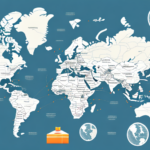Understanding UPS International Shipping Rates with Tracking
Many businesses rely on international shipping to expand their reach and tap into new markets. If you're planning to send your products abroad, it's essential to understand the intricacies of international shipping and the associated rates. UPS international shipping rates are a popular choice for businesses of all sizes, offering a range of services tailored to diverse needs. In this article, we'll provide a comprehensive overview of UPS international shipping rates with tracking, ensuring you have the insights needed to optimize your global logistics strategy.
The Importance of International Shipping for Businesses
Expanding your business to international markets can be a game-changer, unlocking new opportunities for growth and profitability. According to the Statista 2023 report, global e-commerce sales reached over $5 trillion, highlighting the vast potential of international trade. However, international shipping can be complex, with varying rules and regulations depending on the destination country. UPS provides reliable and efficient shipping services that help navigate these challenges, ensuring your packages arrive on time and in optimal condition, no matter where they’re headed.
How Does UPS Calculate International Shipping Rates?
UPS international shipping rates are determined by several factors, including package weight and size, origin and destination countries, chosen delivery speed, and the level of insurance required. UPS also accounts for additional services such as customs clearance and the handling of hazardous materials. Rates are calculated using the UPS Rate and Service Guide, updated annually to reflect changes in the global shipping landscape.
Businesses can benefit from UPS discounts for high-volume shipments or contractual agreements. Additionally, rates may fluctuate based on market conditions and fuel prices. To obtain an accurate estimate of international shipping costs, it's advisable to use the UPS online shipping calculator or consult with a UPS representative.
Factors That Affect UPS International Shipping Rates
Several factors influence UPS international shipping rates, including:
- Package Dimensions and Weight: Heavier and larger packages incur higher shipping costs.
- Destination Country: Shipping to remote or less accessible locations may be more expensive.
- Shipping Speed: Faster delivery options like UPS Worldwide Express cost more than standard services.
- Additional Services: Services such as customs clearance, insurance, and handling hazardous materials can increase costs.
- Customs Duties and Taxes: Depending on the destination country’s regulations, additional duties and taxes may apply.
Understanding these variables helps in accurately estimating shipping costs and avoiding unexpected expenses. Moreover, the type of items being shipped can impact rates, especially if they are classified as hazardous or restricted. Always verify with UPS and the destination country's regulations to ensure compliance.
Understanding UPS Tracking: How It Works and Its Benefits
UPS tracking allows you to monitor your package's journey in real-time. Accessible via your UPS account or the UPS mobile app, tracking provides updates on the estimated delivery date, current location, and any potential delays. This visibility enhances planning and ensures timely receipt of packages.
Additionally, UPS offers customizable delivery options through UPS My Choice. This service enables you to:
- Change Delivery Addresses: Redirect packages to a different location if you're unavailable.
- Reschedule Deliveries: Adjust delivery dates to suit your schedule.
- Hold for Pickup: Collect packages from a UPS location at your convenience.
These features provide flexibility, enhancing the overall shipping experience.
The Different Types of UPS International Shipping Options Available
UPS offers a variety of international shipping services tailored to different business needs:
- UPS Worldwide Express: Guarantees delivery within 1-3 business days to over 220 countries and territories.
- UPS Worldwide Expedited: Provides fast and affordable shipping for less time-sensitive packages, typically delivering within 2-5 business days.
- UPS Standard: A cost-effective option for shipments within Canada and Mexico, offering reliable delivery services.
- UPS CampusShip: A web-based solution that enables businesses to manage shipping operations from multiple locations.
- UPS Worldwide Saver: Ensures fast and reliable delivery, ideal for urgent shipments requiring timely arrival.
- UPS Worldwide Express Freight: A premium air freight service guaranteeing delivery of heavy shipments within 1-3 business days.
Additionally, UPS provides technology solutions like UPS WorldShip, a desktop shipping software that streamlines shipping operations from a single platform.
How to Prepare Your Package for UPS International Shipping
Proper preparation is crucial for ensuring your package arrives safely and complies with international regulations:
- Packing: Use durable packaging materials and secure contents to prevent damage during transit.
- Labeling: Clearly display the recipient's address and include contact information. Ensure labels are weather-resistant.
- Documentation: Complete all necessary customs forms accurately to avoid delays. Include invoices, packing lists, and any required permits.
- Secure Services: For sensitive packages, consider using services like signature tracking or return receipt to ensure secure delivery.
Be aware that certain items are prohibited or restricted from international shipping, such as hazardous materials, weapons, and specific food or plant products. Always verify with UPS and the destination country's customs office to ensure compliance.
Tips for Saving Money on UPS International Shipping Rates
International shipping can be costly, but several strategies can help reduce expenses:
- Utilize Online Shipping Tools: Print labels and schedule pickups online to save time and potentially access discounted rates.
- Optimize Package Weight and Size: Use compact packing materials and eliminate unnecessary items to reduce weight and dimensions.
- Ship in Bulk: Consolidate shipments to take advantage of volume discounts offered by UPS.
- Compare Carriers: Evaluate rates and services from different carriers like FedEx, DHL, and USPS to find the most cost-effective option for your needs.
- Use UPS Packaging Services: UPS offers custom boxes and envelopes that not only protect your items but may also qualify you for additional shipping discounts.
Understanding Customs Clearance and Its Impact on Your Shipment
Customs clearance is a vital step in international shipping, involving the inspection and processing of goods by customs authorities. UPS offers comprehensive customs clearance services to facilitate smooth and efficient processing of your packages. However, customs clearance can introduce additional time and costs, including potential fees and taxes that must be settled before your package is released.
The nature of the goods being shipped significantly affects the customs clearance process. Items such as hazardous materials or products under trade restrictions require extra documentation and inspections, potentially delaying delivery. It's essential to research and understand regulations or restrictions related to your shipment beforehand.
Efficient customs clearance also enhances the security of your shipment, as authorities inspect packages to prevent the transit of illegal or dangerous items. Partnering with a reputable shipping provider like UPS ensures that your packages are handled securely and in compliance with all regulations.
Common Issues with UPS International Shipping and How to Avoid Them
While UPS is known for its reliability, international shipping can sometimes encounter issues such as delays or lost packages. To mitigate these risks:
- Ensure Proper Packaging: Secure and appropriately sized packaging reduces the risk of damage and loss.
- Accurate Labeling: Clearly label packages with correct addresses and contact information to prevent misrouting.
- Compliance: Adhere to all destination country regulations to avoid customs delays or confiscations.
- Use Tracking and Insurance: Utilize UPS tracking to monitor your shipment and consider insurance to protect against loss or damage.
Choosing a reliable carrier like UPS, combined with careful preparation and adherence to shipping guidelines, significantly enhances the likelihood of a smooth international shipping experience.
Comparing UPS International Shipping Rates with Other Carriers
When selecting an international shipping carrier, it's important to compare rates and services to determine the best fit for your business:
- FedEx: Known for its extensive global network and reliable delivery services.
- DHL: Offers specialized services in certain regions and industries, often providing competitive rates for specific routes.
- USPS: Provides cost-effective options for less urgent shipments, particularly for smaller packages.
Factors to consider when comparing carriers include:
- Destination Coverage: Some carriers have stronger networks in specific regions.
- Delivery Speed: Evaluate the delivery timelines offered by each carrier.
- Cost: Compare base rates, additional fees, and available discounts.
- Service Reliability: Assess the carrier's track record for on-time deliveries and customer satisfaction.
By thoroughly researching and comparing different shipping carriers, you can select the most advantageous option for your international shipping needs.
The Future of UPS International Shipping and Technology Advancements
The global shipping industry is continually evolving, with technology playing a pivotal role in enhancing efficiency and customer experience. UPS is at the forefront of these advancements, investing in technologies such as advanced tracking systems and automated sorting to streamline operations.
Sustainability: UPS is committed to reducing its carbon footprint through initiatives like investing in alternative fuel vehicles, optimizing delivery routes to lower emissions, and developing sustainable packaging materials. According to their sustainability report, UPS aims to achieve carbon neutrality by 2050.
E-commerce Integration: With the exponential growth of e-commerce, UPS is enhancing its capabilities to support online retailers. This includes expanding its network of distribution centers, improving last-mile delivery solutions, and integrating more sophisticated technology to handle the increased volume and complexity of e-commerce shipments.
Automation and Robotics: UPS is exploring the use of robotics and automation in its facilities to increase efficiency and reduce processing times. Innovations like autonomous delivery vehicles and drones are being tested to revolutionize the delivery process.
As UPS continues to adapt to technological advancements and market demands, businesses can expect more streamlined, cost-effective, and sustainable shipping solutions that support global commerce and growth.





















